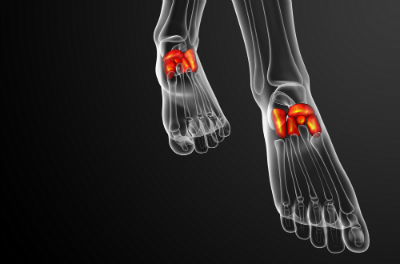Midfoot Anatomy – Meet the Lisfranc Joint Complex
It is an understatement to say that we have a lot of options for adults and youth to participate in sporting activities here in our Dallas-Fort Worth community. Whether a student participates on a team at North Dallas High or an adult is looking to play rec soccer, volleyball, or football, there is simply an abundance of opportunities. This also means there is an abundance of opportunity for athletes to sustain foot or ankle injuries, including midfoot injuries!
 The foot can be viewed as having three distinct areas – the forefoot, midfoot, and hindfoot regions. Each has its own set of injuries that tend to be more likely than others. At Dallas Podiatry Works, we treat patients who have many different foot or ankle issues that arise, including a host of midfoot injuries.
The foot can be viewed as having three distinct areas – the forefoot, midfoot, and hindfoot regions. Each has its own set of injuries that tend to be more likely than others. At Dallas Podiatry Works, we treat patients who have many different foot or ankle issues that arise, including a host of midfoot injuries.
The midfoot, as logic dictates, is the middle region of the foot. In this region, there are several small bones that are essential for establishing and stabilizing the arch. These bones are connected and held in place with ligaments that run across and down the foot. There is an exception to this in the fact that first and second metatarsal bones are not connected to each other.
Collectively, this midfoot area is referred to as the Lisfranc joint complex. Within the midfoot, there are five tarsometatarsal (TMT) joints. For the first three, the metatarsal bones correspond to the cuneiforms (medial, middle, and lateral), whereas the fourth and fifth correspond to the cuboid. The cuneiform and cuboid bones are stout and found closer to the hindfoot. The metatarsal bones are longer and somewhat thinner.
This is important to know because of the various types of common midfoot injuries that can develop due to physical trauma or other injury. Sprains, fractures, and dislocations are all possible when the foot twists in an abnormal fashion. All of these injuries share a similar set of symptoms, so it is important to come in for proper diagnosis whenever pain develops in the Lisfranc joint complex.
When you do come see us here at Dallas Podiatry Works, we may use diagnostic imaging (X-ray, MRI) to determine the nature and extent of the injury. Once that is established, we will create a custom treatment plan to promote optimal healing and get you or your loved one back to favorite activities as soon as possible.
Call us at 972.853.7100 and we will be happy to answer any questions you might have or provide additional information. If you’d prefer, simply go ahead and schedule your appointment with either our Plano or Dallas, TX offices online today.

 The foot can be viewed as having three distinct areas – the forefoot, midfoot, and hindfoot regions. Each has its own set of injuries that tend to be more likely than others. At Dallas Podiatry Works, we treat patients who have many different foot or ankle issues that arise, including a host of midfoot injuries.
The foot can be viewed as having three distinct areas – the forefoot, midfoot, and hindfoot regions. Each has its own set of injuries that tend to be more likely than others. At Dallas Podiatry Works, we treat patients who have many different foot or ankle issues that arise, including a host of midfoot injuries.


